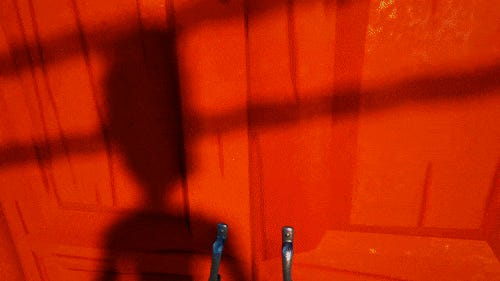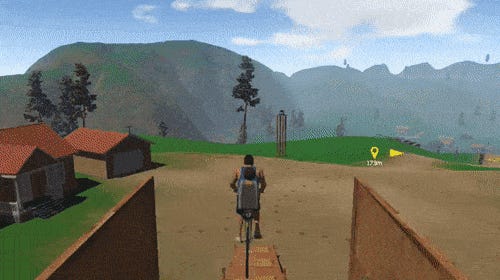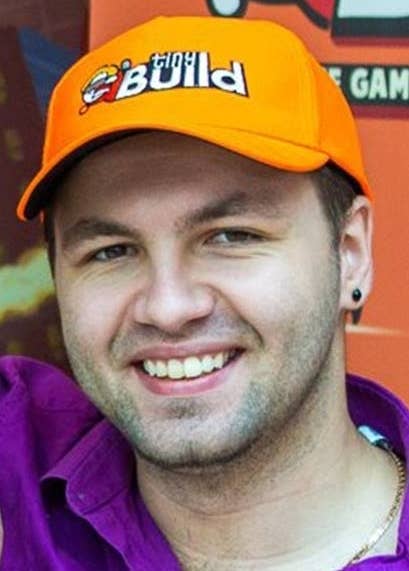How to pitch your indie game
TinyBuild CEO Alex Nichiporchik offers advice on how to win over publishers, press and more
So, you've got your game in development and have decided you need a partner to help make it even bigger. That's a smart idea -- you want to focus on the game itself and having an experienced partner can help you get your creation in front of as many eyeballs as possible.
This article is meant to help you effectively pitch your game to publishers, journalists, YouTubers, streamers, or maybe just your cat.
I actually think the word "publisher" is irrelevant in today's industry, as what you really want is a partner that'll help you create something long-lasting. So let's switch up "publisher" to "partner" for the sake of this article.
Elevator Pitch
You're in an elevator. I'm standing there wearing my stupid orange hat. We have six seconds before we get to the right floor. I ask you about what game you're working on. Practice this reply.
"You're in an elevator. I'm standing there wearing my stupid orange hat. I ask what you're working on. Practice this reply."
Being as cheesy as "Mario Kart As a 2D Platformer" works. It gives me an idea of what the game is and it spawns a conversation. "Does it work online?" I'd ask, and if you tell me it's a competitive online platformer -- we might just have SpeedRunners.
Always have your business card on you. If you want to take it to the next level, make sure that card has a Steam key or a short link to your game's demo and/or asset pack.
Back to the pitch. Think about what makes your game interesting. Sometimes being generic and referencing other games works. "Have you ever had loud neighbors?" Everyone will nod or say yes. "Did you ever want to stab them? That's the game," and you might have Party Hard. Or "Nuclear Throne meets Deus Ex with the anarchy of GTA" and we'd have Streets of Rogue -- that's the literal store description we've been using for years.
Make sure to practice this in front of the mirror, say it loud and clear. Don't go deep into explaining the mechanics, just get people interested. Be memorable. It helps if you're memorable as well. If you're pitching via email, just add something personal to it -- a GIF of you doing something or, even better, a good GIF of the game.


Visuals
Let's assume you managed to pique my interest. At this point, it doesn't matter if I'm a publisher, a journalist, or a platform holder. Show some great visuals. In an email, make a stunning (and under 3.5MB) GIF of the game. Just drop it into the body of the mail. You have no idea how effective this can be. Everyone checks their email on phones, so having something that loads in and plays right there is invaluable. It also shows how that visual can grab attention in marketing.
Remember, it's not rude to make emails short and to the point. The same goes for personal meetings. Everyone's time is valuable, and if you feel like writing a novel works better than a short, spot-on message, you need to understand that people's time is very limited. So is the attention span of potential users. If it catches my eyes within a crowded environment when you are showing live visuals, odds are it will catch attention of users, YouTubers, streamers, and the press.
If you're sending an e-mail, include a "naked" unlisted Youtube link to the trailer and/or gameplay montage. Make sure the interesting things are visible within five seconds of the video -- yes, you will lose people at that long splash screen. If your game is slower paced and story-driven, pull a Hollywood-style trailer with a quick montage in the very first five seconds. Most email clients now preview video links to YouTube, and it's effortless to click on a link to watch a quick video. Especially if I have already seen a cool GIF in the body of the mail. All of this applies to press and users, too. And please, stop using Vimeo links with passwords.
Description
Don't go deep into the story behind the game, and especially don't write a novel-sized text regarding it. Use short, easy to scan bullet points of why you believe your game is great. Do something to stand out and don't forget -- be clear and concise.
Here's an example:
- Online multiplayer FPS
- Built in Unity
- Using Photon Engine
- Target platform PC, works well with controller
- Trailer link
- Need help with marketing, financing
- Inspired by Tribes
Keep it simple. If I like what I've seen so far, including the GIF and trailer, and the brief description that I'll spend about 10 seconds scanning, we will get on a call to talk about what you actually need, your ideas on how to release it, and so on.
If you need funding, explain why and what it'll be used for. Even better, have a budget plan prepared.
If you have released games before, that's a huge accomplishment and it means we know you can complete projects. Even if it's something on a different platform or other business model -- having shipped games is always an advantage.
Got a build? Great!
Make a build that has a vertical slice of gameplay. Something that shows off why your game can be fun. Think of it like this -- if this build was at a convention, where thousands of people walk by, how can you make them interested in picking up the controller, quickly grasp the gameplay, and draw them in?

Getting this done properly is best achieved by just going to any kind of public gaming showcase. Search for anything in your area, it doesn't have to be big or expensive. Get something together, get a laptop, and see how people react.
The first time we showcased SpeedRunners at PAX, we were literally squatting at a convention with a laptop strapped to Luke Burtis's neck, and four controllers hanging on velcro. We realized people like very specific things in the game, and focused on them. Specifically, it was all about that "game feel" which sparked a very competitive emotion in players. That's when we knew we'd need to get the game to YouTubers before those became a thing. The rest is history with one of our most popular games to date.
Look for what makes people smile. And for everyone's sake, do not try to explain to people how to play it -- see what they naturally try to do. You have the option to present visual, interactive information on the screen. Don't distract players with talking about the game, just lean back and observe what they're trying to do based on what they see. Take notes on what they don't understand, and improve your build based on that.
Get that type of build to a potential partner and we'll squeal, thinking about how perfectly it would work at a showcase, how easy it is to get into, how the onboarding experience is great, how great the UI is, and so on.
So you have your build, great. Send it over as a Dropbox link. Seriously, just use Dropbox -- we are often traveling and have crappy wifi, doing a "save to my Dropbox" works perfectly because the file will eventually download. Avoid using private FTPs or local Dropbox alternatives, because odds are I'm somewhere in the middle of nowhere and that location won't have a CDN for anything other than Dropbox.
Had press? Great, talk about it
If you had Lets Plays of your build, that's fantastic! Even if they're not great or from huge players, send them over. It's important to see how the ever-changing and evolving landscape of "new media" -- YouTubers, streamers, and who knows what's next -- reacts to your game.
So, to sum up...
- Have a short, tangible, interesting pitch
- Include a cool visual GIF (under 2MB!)
- Include a link to a (within five seconds) interesting YouTube trailer -- it can be unlisted
- Brief description, preferably in bulletpoints -- don't forget to mention what you need
- A build that's easy to play
Congratulations. You have just increased your chances of getting a strong partner, featured by the media, or a great platform deal. Even better, people will recognize your game now.
And even if you decide to go alone, the groundwork you did will help your game become more successful. If you want to make your game into a long-lasting franchise that people will still be playing ten years from today -- let's talk.
What's Your Actual Goal?
Before you go on and do great things, hopefully inspired by this article, I'd like you to ask yourself -- what's the actual goal here?
Is it to get funding? Is it to get help with marketing? Is it to get the game to every platform out there? Ask yourself these questions first.
What I've been asking developers recently is in regards to future plans. At TinyBuild, we have realized that indie publishing is a "flip-based" business, where mostly one-off deals happen without a clear strategy towards a bigger goal. That's why we're expanding partnerships with developers by scaling up studios. That's why our team is not really interested in just publishing a single game. We're looking for more long-term partnerships to create brands that'll last a decade or even a generation from now.
Alex Nichiporchik is the CEO of TinyBuild Games. Before co-founding the indie publisher, he was a pro-gamer, a games journalist, and game producer.








